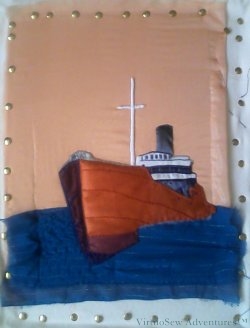
Transferred to stretchers
When I began to attach the slip, I needed to make sure that the background would be smooth and straight, so as the floor frame was failing to achieve that, I transferred the work to an old set of stretcher bars and used plenty of drawing pins to attach the fabric. I wasn’t concerned about holes in the fabric because the pins were well outside the area of the design that would be on show.
This photo shows the slip of the hull and superstructure, the funnel, and the masts finally attached. Each area was firmly sewn on using a suitable colour of stranded cotton (several different colours in the the case of the hull!), and the holes for the anchor chains were held down to let the background show through.
There are some small elements which yet need to be done on the ship – notably the rigging, but the next important element is the quayside. I had originally picked out two upholstery fabrics to choose between, one of them dark and heavily patterned, and the other lighter and smoother, but as it turned out both of them came in useful….
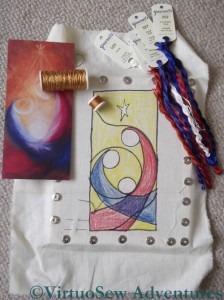
Christus Natus Est - Materials
I know I should try to limit the number of projects I work on at once, but my fingers have been itching to start the Christus Natus Est Panel, and I finally decided to have a go.
I bought the silk thread (Pearsall’s Filoselle) and the gold passing thread, at the Knitting and Stitching Show in Harrogate last year. The Filoselle is a beautiful stranded thread, and I’m using a single strand to couch down the colours of the thread, and a different, very fine thread to couch down the bare gold sections.
I was somewhat afraid that choosing to work my or nué panel in the circular and curving fashion would create considerable headaches, especially in starting the spiral at the centre of the circle, but actually it was fairly straightforward. I’ve put the gold thread into a little gauze bag, which keeps it from unwinding- mostly- and means I don’t have to worry about it snagging or catching as I work
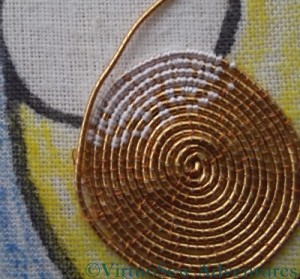
Close-up of Starting The Or Nué panel
As my spiral becomes larger, and the number of colours I am using in each circuit increases, the work will become slower, and more confusing, but so far, I am enjoying it very much. It would be much easier if I had a proper slate frame and trestles to stand it on, as I can see that the pins holding the calico to the frame will need to be moved occasionally as the fabric stretches. However, the silk thread covers the gold reasonably easily, and since I was aware from reading about the technique that the silk would distort the rows slightly, I’ve not been unduly disturbed by the way the spiral isn’t quite circular anymore. It won’t be that obvious when the piece is finished, after all!
In fact I’ve been enjoying myself so much that I just have to be a little careful not to get so wound up in it that I stitch for too long and end up with fuzzy eyes!

Tulip Needlework Nibble - image from Thistle Threads website
Encouraged by the success of the Needlework Nibble that supported the Museum of Costume in Bath, Tricia at Thistle Threads has launched another fundraising Needlework Nibble, this time to support the exhibition With Cunning Needle: Four Centuries of Embroidery at Winterthur Museum.
I’ve enjoyed the Glittering Snail, and the two Thistle Threads courses I’ve been following, so I’ve ordered my kit, and the finishing kit to go with it. I’ve printed out the instructions, as well.
Tricia has already reported that the fundraising is going well – about halfway to the target, thanks to the generosity of one of her readers who has matched the first thousand dollars raised. That means there are still kits available, although they are clearly moving fast.
Why don’t you join us?
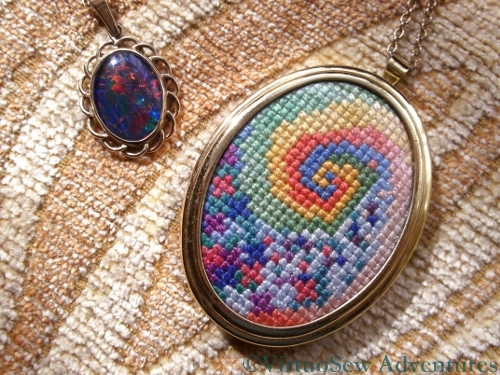
Design And Inspiration
Some years ago (in fact long before we were married) my husband the Australian bought me an Australian Opal Triplet pendant. It’s really stunning, and when it catches the sunlight it takes people’s breath away.
At about the same time, I received a Framecraft pendant blank with a magazine I’d bought, and found myself thinking it might be fun to create a sort of Homage To The Opal.
I still have, somewhere, a whole sheet of coloured design ideas that never made it to a chart, but anyway, here is the final result. It combines a swirling spiral (inspired by the simple gold wire setting he designed for the stone) with some basic “flower” shapes intermingled to create the effect of the changing colours of the stone. The colours were picked to echo the colours in my opal triplet – naturally each opal is different.
The embroidered version is worked in counted cross stitch on 18hpi aida using variegated silk threads, and although I know I am not exactly an unbiased judge, I think it is lovely, and I very much enjoy wearing it!
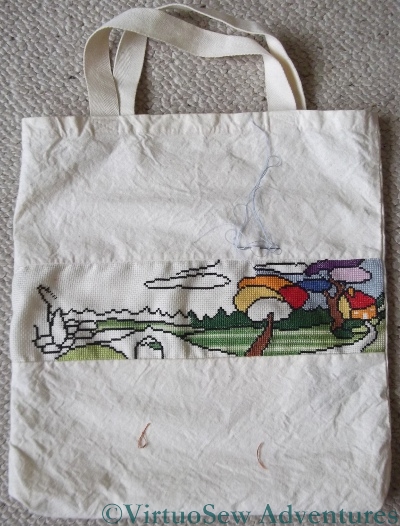
Cotton Bag with Aida panel, beginning the Design
Here is something else I have found in a heap of things to finish…
This cotton tote bag with an aida panel across the front was a free gift with a magazine, several years ago. It must have been about the time I was designing the series “Inspired by Clarice Cliff“, and it probably seemed a good idea to cover all the aida, rather than having threads stretching across the back of the stitching.
It’s a real trial to stitch, though. I’m not at all surprised it ended up at the bottom of the workbasket. If the handles don’t get in the way, the rest of the bag does. Since it is made without a seam at the bottom, I can’t even release the seam to make life easier, although I admit that doing so might not help as much as you’d hope.
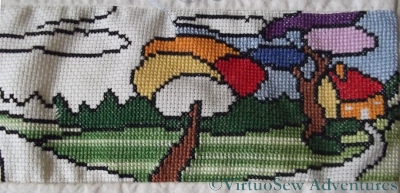
Another Clarice Cliff Inspired Design
Here is a close-up of the design as far as it is stitched. I’ve used Anchor Stranded Cotton, and the variegated thread is one of Anchor’s standard variegated threads. I’ve stitched the primary section in that thread in two phases of half-cross stitch, to spread out and change the colour effect a little.
This is going to be my “travelling project” until it is finished, as when I sort out the threads it should be quite compact, and it’s not such fine and delicate stitching as most of my other current projects. As I don’t travel regularly, it will be a while before you see it again.
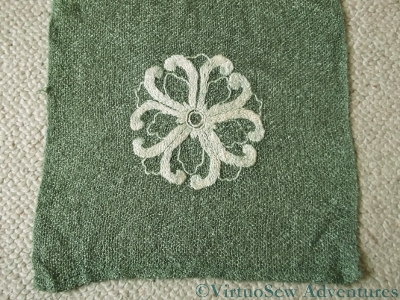
Scarf End
This is a long rectangular scarf in a very open weave, woven using a textured yarn. I bought it on the high street, but decided to embellish it somewhat. At the time I was fed up with embroidered pictures and wanted to embroider something useful. Life no longer being leisurely enough to require a huge stack of teacloths or placemats, clothes seemed an obvious choice.
I also wanted to play with a soluble fabric. Soluble fabrics are usually used for machine embroidery, but naturally I had other plans!
The embroidery thread was one of the Caron Collection three-stranded cottons – from the Watercolours range, I think, and the design is based upon a Chinese heraldic badge depicted on one of the designs in “Traditional Chinese Designs: Iron-on Transfer Patterns”, produced by Dover books. Of course I didn’t iron it on…!
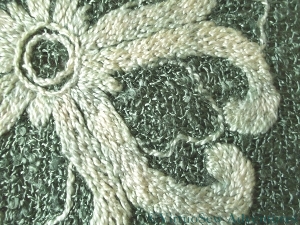
Scarf Motif - CloseUp
As you can see, most of the design is worked using closely packed long and short stitch, with the thin lines worked in double running stitch. This makes the design close enough to reversible to cope with the odd gust of wind when I’m wearing it!
You might be wondering what use the soluble fabric was. It was very useful in fact, because it allowed me to put stitches in the middle of holes in the weave of the scarf without them pulling to the edge of the hole before I’d locked them in place with the next row of stitching. The stitch length is pretty constant throughout the piece, and that’s because my stitch placement wasn’t undermined by the base material.
You could argue that a backing fabric would have done that job without messing around with soluble fabric, and you would be right. But such a backing fabric would have permanently altered the appearance and drape of the scarf, and I liked it the way it was.
I still do!
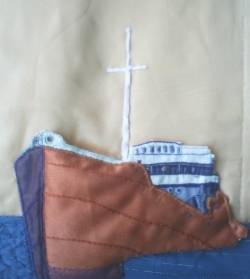
Stepping the Mast
While I was attaching the hull, I was also looking at my references on Stumpwork, or Raised Work. The headache that had been looming all the way through to this point was, How Shall I Do The Mast?
I tried to cover straws with thread or find narrow pieces of plastic or wood, and all of the attempts looked clunky and un-seaman-like. I thought about trying to use stitching – either satin stitch or lines of stem stitching, but in the end decided that these elements needed to be smooth and relatively featureless, whereas the stitching in the piece is entirely to create detail. When I thought a bit harder, it seemed to me that the mast and spar weren’t mere “details” and that there would be a rather jarring effect if I created them using a “detail” technique, rather as though they’d been magnified, or something like that.
In the end I decided to continue using only fabric in the piece. This meant a slightly more difficult process, as the mast and spar are narrow and need to be rounded, but it also maintains the integrity of the design as a purely fabric appliqué.
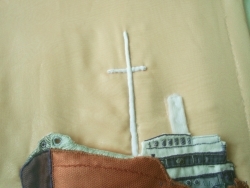
Mast Close Up
So: the mast and spar were padded with slivers of felt and covered with narrow cotton tape. This made the ends slightly tricky (the tape kept trying to fray), but provided a clean edge on either side of the spars.
I also attached the padding for the funnel to the background. Both of these needed to be attached before the entire slip for the hull and superstructure were entirely caught down, but at the same time I couldn’t be sure of the placements (wretched shrinkage!) until I had the slip in place.
Every now and again, I find early – and usually not-quite-finished – embroidery projects stashed away in a quiet corner. This is a case in point.
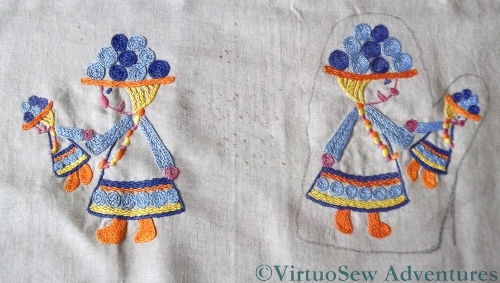
Found Among Our Forgotten Projects
This is very early indeed, probably from my first year of embroidering. The design came from a very nineteen-seventies book of embroidery designs that will have to remain nameless unless I can find it again. I suspect that I went for this design because it was in colour rather than variations of Mud!
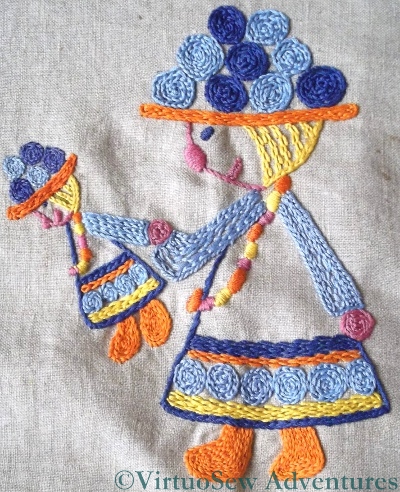
Girl And Doll Design Close Up
Other than that, I can’t find any excuse for it at all. The design was intended to embellish oven mitts, and when I get a chance I will probably finish them to make a pair and then put them in a church bazaar. Alternatively, I might outline the glove shape on both and then turn the fabric into a bag, which would be rather more use than home-made oven mitts now we all use those fire-retardant gloves.
I have noticed, however, that my passion for experimentation showed itself even at this early stage. I’m absolutely certain that the sleeves didn’t have that Closed Feather Stitch stripe down them in the original piece.
I also distinctly remember that I nearly ran out of thread and had to do some some very economical stitching to get everything stitched in the threads I’d picked out.
I’ve not really been making as much progress with the silkwork on the Masterclass Sampler and Tudor Pincushion as I would like. The weather has been cold and overcast, making my best stitching spot for natural light a chilly and uninviting place. Artificial light produces a confusing glimmer on metal threads, so unless it is a particularly easy stitch, I tend not to use metal threads in the evening.
I’ve been more or less keeping up with my practice stitching, however, and this month’s stitches are Cable Chain Stitch, and Knot Stitch (also known as Braid Stitch). I enjoyed these very much, as I already know them both, and it was good to be able to add them to the practice cloth and remind myself of my repertoire.
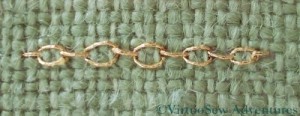
Cable Chain Stitch
Cable chain is my absolute favourite of the chain stitches, and pops up in all sorts of projects. I used it in the Jacobean Firescreen that I’ve used as my header picture, and the Jacobean Work panel that I’ve yet to find a use for, and on the dorsal fin of the Experimental Seahorse. I’ve even used it on the Map of Amarna, in the Compass Rose. I think that it looks its best using a fairly heavy round thread, so on my practice cloth the gold is somewhat out of scale with the fabric
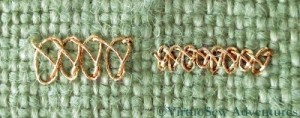
Braid Or Knot Stitch
Braid or Knot Stitch (not the terrifying Plaited Braid Stitch that I haven’t got to grips with yet!) is another favourite. I used it to create the Prince’s bow in the first of the Persian Fantasy Panels. I also used it for the ice cream cone part of the logo on the Frolicking Teddies Cot Blanket. I worked the stitch at two different scales, so you can see it looks a little loopy and untidy over four threads, but neatly ornate over two.
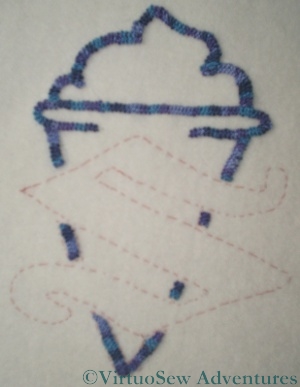
Cone In Braid Stitch
The logo on the Frolicking Teddies Cot Blanket was an interesting element to work. It consists of a letter “S” superimposed over an ice cream cone. Clearly as a graphical element, it needed to be consistent in feel – achieved by using the same thread in each part of the logo – but I also felt that stitches that would work for the “S” might not work for the ice cream cone.
In the end, I used the ordinary Braid Stitch for the ice cream cone, producing a strong, textured line. This is actually an easier stitch than it looks, and in fact when I have a broad line to cover, braid stitch is one of my favourites.

Logo for the Family Business
The “S” was a slightly harder question. I wanted it to be solid and “blocky”, and yet not to have excessively long stitches that might catch. I also wanted the thread to show to its best advantage. In the end I stitched most of it in vertical satin stitch, but outlined it in stem stitch and then created an ornamental line down the widest part, taking my cue from the pierced effect sometimes used for capital letters in illuminated manuscripts. I think this may well be the element I am most pleased with!
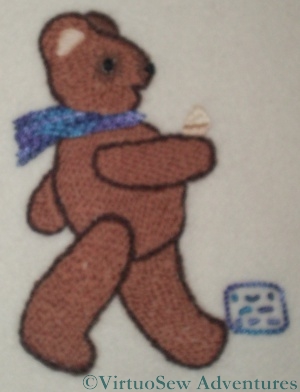
Morse Code Teddy
As this was a commission, of course I signed my work. One of the Marching Teddies is kicking a small cartouche in which my initials are worked – in Morse Code, as has become my habit, using French Knots and Bullion Knots.
I decided to line the Cot Blanket. With silk, of course. Although I rather doubted that it would be used except on special occasions, I thought it would be better to protect the back of the work from little kicking feet and little sharp nails! Attaching the lining was a time consuming operation, since I had to make sure it was very firmly attached, without pulling or dragging at any point.
I also provided a tiny leaflet explaining the idea of the design and saying a little about how it was done. This was my very first real commission, and I am glad to report that the client was delighted.


















